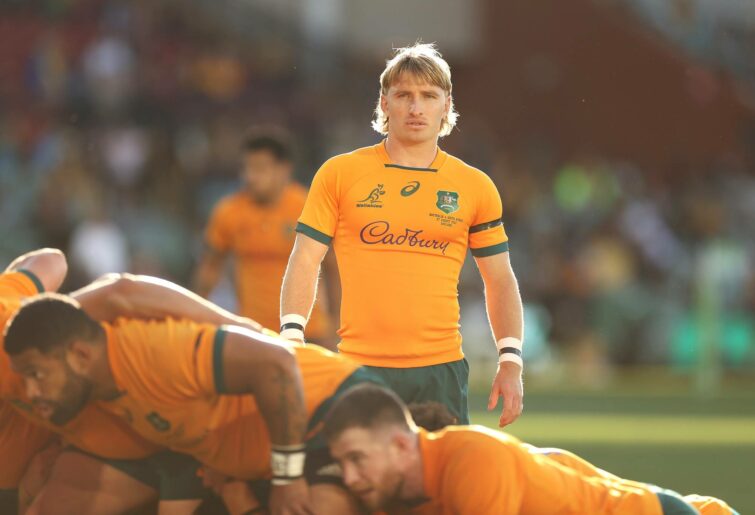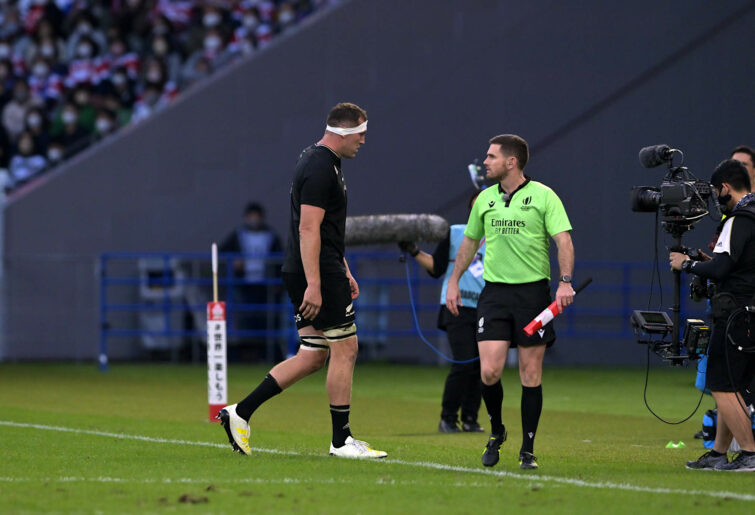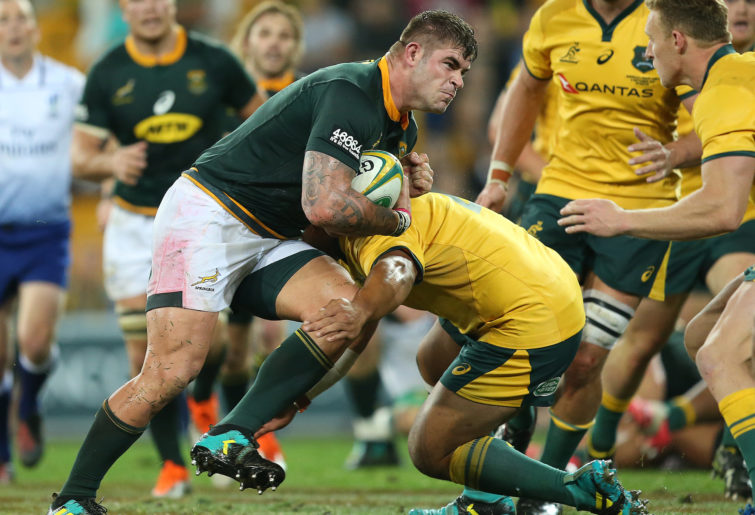Rugby Australia’s press release yesterday called the Wallabies’ victory a “gritty win”. 16-15, away from home at Murrayfield? No argument there; that’s peak gritty.
Another view might be that this was a match both teams seemed intent on losing, and Scotland proved just that wee bit more clinical at not taking the opportunities presented to them.
In a week’s time, most of the detail will be forgotten; surely a good thing, because this was not a Test match for the ages, not one to pull out one future Xmas holiday to convince the grandkids that this is the game they play in heaven.
The Roar experts Brett McKay, Harry Jones and Jim Tucker discuss the Wallabies’ win in the Instant Reaction Podcast
What won’t be forgotten is that it this was a badly needed win for Dave Rennie and his team, and that the record will show a ‘W’. Just as every golfer knows when a thinned approach shot rolls up and over a couple of mounds, finds its way onto the green, and miraculously into the hole, you don’t have to write an explanation or draw a picture on the scorecard. It is only the score that matters.
And when a coach like Rennie is held to account for an unsatisfactory win-loss record, it’s is only fair that the wins are paid due respect, no matter how narrow, no matter how gritty.
The Wallabies found space early, with Scotland slow to adjust to Tate McDermott’s running game. But the pattern of the game soon established itself and it wasn’t good news for the visitors.

(Photo by Mark Kolbe/Getty Images)
Scotland were more energetic and purposeful at the breakdown, in contrast to the Wallabies who seemed hesitant and uncertain in their ball transfer and cleanout.
So poor was the Wallabies’ red zone conversion, in a frustrating first half, on attack in the 22, they were picked off twice at the breakdown, Rob Valetini lost front-foot possession with horrible ball presentation, a fourth ball spilled out of the ruck into Scottish hands and a fifth attacking ball was lost when McDermott was too slow to clear.
As far as ratios go, that’s up there with the worst, and it was almost mystifying that Australia somehow went into the sheds at half-time ahead by 6-5.
The second half started disastrously; a move from an attacking scrum fouled by two poor passes by McDermott and Hunter Paisami, before Bernard Foley collapsed in a heap, losing the ball, allowing Blair Kinghorn to toe ahead and score.
Scotland had opportunities to press home the advantage, but one thing the Wallabies did get right was their maul defence; the hosts repelled multiple times when it was their turn in the red zone.
As the match entered the final quarter the Wallabies finally found some fluency; Nick Frost handling well at first receiver before Cadeyrn Neville popped a nice short ball to James Slipper to finish.

James Slipper (Photo by Paul Kane/Getty Images)
When Foley missed touch from a penalty, Australian hearts sank, but Duhan van der Merwe and Ollie Smith somehow conspired to let it run over the touchline. This was a key play; Scotland conceding a penalty from the lineout for Foley to give the visitors back the lead, 16-15.
Any hopes that the Wallabies would close the match out professionally and clinically were quickly dashed; Paisami pinged for a deliberate knock down, before Taniela Tupou was penalised at a breakdown, competing for the ball while not supporting his own bodyweight.
For the second time in the match, Kinghorn put too much draw on what should have been a meat and drink kick. Nic White drilled the 22 restart into touch and somehow the Wallabies had won a match they had done everything in their power to lose.
The Wallabies talk a lot about discipline, but seem yet to fully understanding they are judged by their actions, not their words. Take how referee Luke Pearce was heard warning them in the first half about obstruction of kick chasers. Immediately after Slipper’s try, Len Ikitau did just that, and a neutral midfield situation became an attacking lineout to Scotland.
Another telltale sign was the number of voices telling Pearce what to do. Andrew Kellaway was singled out, but he was far from alone. Ten metres for backchat set Scotland up for another 5m lineout.
Better sides, like France and Ireland for example, will not be so accommodating when handed such gifts.
In such a muddled performance, it feels tokenistic to try to single players out, although James Slipper can feel well proud of his all-round effort. Perhaps the rest of his team might take the opportunity this week to remind themselves that Slipper is quite capable of handling the captaincy without so many unhelpful interjections.
And despite his final minute faux-pas, it was heartening to see Tupou back in gold, back looking like he belonged in Test rugby.
The best thing about Saturday was Carlos Spencer stopping in at an Op Shop on his way to Sky Sports’ studio to co-host the New Zealand versus Japan Test in Tokyo.
The next best thing about Saturday was that it bought to an end the messy controversy over the scheduling clash between this match and the Women’s World Cup quarter-final clash between the Black Ferns and Wales.
NZ Rugby deserved all of the criticism it copped last week, albeit some it becoming increasingly unhinged as the week unfolded, where claims of a misogynist conspiracy were being liberally and loosely bandied about.
A conspiracy to demean women in rugby? Sometimes stuff-ups happen, people. It’s not as if NZ Rugby doesn’t have form in that area.
The All Blacks’ roller-coaster ride through 2022 continued, their scrappy 38-31 win doing nothing to stem disquiet over the direction of this team, less than a year out from a World Cup.
Despite swarming Japanese defence throughout, the All Blacks’ ball retention was actually reasonably sure, albeit the attack lacking in penetration. What was less impressive was a lack of connection in defence; this looseness allowing Japan to claw their way back into the match prior to half-time, and to stay in touch thereafter.
Other woes centred on a lineout that started shakily and got worse as the match went on and a kicking game that can most kindly be described as directionless.
For their part, Japan were as inventive as ever with the ball, but it was their smothering defensive effort that really caught the eye; one which suggests that they will once again be a handful in their World Cup pool; expect Eddie and Cheik to be comparing notes sometime soon.

(Photo by Mark Evans – RFU/The RFU Collection via Getty Images)
The individual highlight was a brilliantly freakish try to lock Warner Dearns, whose charge-down of a Finlay Christie kick somehow stuck, and allowed him a clear 40-metre run to the line.
The match threw up plenty of talking points, starting with the All Blacks’ second try, to Braydon Ennor, which again highlighted an area where rugby has its review process wrong, and how it can learn from rugby league.
TMO Marius Jonker interjected to draw attention to a forward pass by Richie Mo’unga in the lead-up. It seemed an obvious call to make.
Referee Nika Amashukeli was perhaps the only person in the stadium to see things differently, citing no clear evidence to overturn the try, leaving Jonker to ponder the purpose of his role.
Despite the introduction of TMOs, and the assistance provided by the two assistant referees, decision-making in rugby remains the sole discretion of the referee. That’s reflective of a noble but outdated mode of operation, appropriate for when the referee really was the sole man in charge, but unsuitable for today, where there is a committee of match officials and a bank of high-definition TV monitors upstairs.
As it stands, the TMO has become a fourth voice at the table; adding not clarity, but more potential for dissent and delay. To be clear, this is no cry for ‘more TMO’, just a desire to use the TMO more effectively.
The solution is simple and obvious: once a matter goes upstairs, the decision-making responsibility should shift to the TMO. By all means let the referee continue to make his call, and have that carry weight, along the lines of a requirement for there to be a ‘clear and obvious reason’ to overturn his original decision.
But spare us the farce of having referees ask, “Are we all agreed?” and the TMO, with far better visual tools at his disposal, patently disagreeing but lacking authority, having to slink back in his chair and make himself scarce.
The other contentious event was the red card issued to Brodie Retallick. For the ‘what else was he supposed to do?’ crowd, Retallick always had the option not to enter contact as he did, opting to concede the turnover to Kazuki Himeno. He also created a rod for his own back by cleaning out with the point of his shoulder, without a clear arm-wrap.

(Photo by Koki Nagahama/Getty Images)
On deeper inspection, however, this event was more indicative of the crapshoot that the breakdown has become.
Law 15.3 states that players involved at all stages of the ruck must have their heads and shoulders no lower than their hips.
Himeno’s head was lower than his knees. It can be logically argued that players who do this place themselves in a dangerous position; the very reason law 15.3 exists in the first place.
Of course, this never justifies their being hit dangerously by a player cleaning out. But a player putting himself in that position does make that outcome more likely. And it is outcomes – less head contact – that matter here.
World Rugby’s breakdown working group last met and issued an update in 2020. Ironically, this group included Ian Foster and Joe Schmidt – now almost certain to be without Retallick for the rest of this tour – as well as referees Wayne Barnes and Jaco Peyper.
Whatever happens in the future, there will be no lessening of World Rugby’s emphasis on the responsibility of the cleaning player to avoid head contact. That’s as it should be.
But longer-term, the game will have to look at re-engineering the breakdown, so that players are not encouraged to leave their heads exposed, inches from the ground. For as long as that is sanctioned and the forceful clean-out isn’t eliminated from the game, head and neck contact will continue to occur; accidental and foul.
It seems a no-brainer to stamp out players entering the breakdown at high speed, like Scotland’s Glen Young did, in his attempt to clean out Tate McDermott.
But because players are not allowed to clean out from the side, nor roll opponents from the neck, it potentially becomes a difficult proposition for the support players to effectively clean out using a wrestling motion as opposed to forcing their opponent off the ball.
Concede the turnover to the jackal, I hear you say. Well, yes, but to make it fair, what about applying 15.3? And doesn’t the referee have enough to do without considering how low that player has his head?
In addition to player safety, the big question resides around finding the right balance in the game between attack and defence, and maintaining a contest for the ball.
You can see it a mile off; teams with three specialist jackallers, along the lines of how Malcolm Marx operates now, hanging off the initial contact zone like circling buzzards, before swooping in, benefitting from a de-powered clean-out, to place their hands on the ball, to be rewarded with a penalty?

(Jono Searle/Getty Images)
That doesn’t sound like the kind of rugby I’m hanging out to watch.
It’s an incredibly complex situation; one where the solution goes far deeper than relying on referees to hand out red and yellow cards, or to apply one of rugby’s rarest but oldest laws, last invoked the day William Webb Ellis picked up the ball and ran with it; the bicep mitigation.
The Women’s World Cup semi-finalists were decided, with predictably comfortable wins to France, New Zealand, England and Canada, setting up what hopefully will be some more competitive rugby next weekend.
As predicted, Australia’s Wallaroos, beaten 41-5 by England, were on a hiding to nothing, and Rugby Australia must do everything within its power and resources to accelerate its women’s professional program, before Australia falls even further behind.
In a tournament that has so far struggled to break the shackles, fans on Saturday were treated to some sparkling running and support play from the Black Ferns.
It was a stark reminder that, in today’s mish-mash of caterpillars, box-kicks, scrum re-sets, water breaks, collisions and stray deltoids mistaken for biceps, when the ball is thrown into space and players run onto it at full pace, rugby can be the most exhilarating of games.

































































































